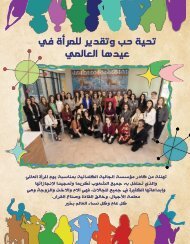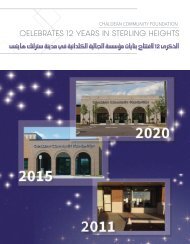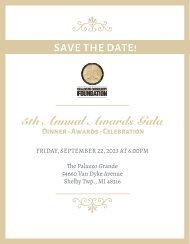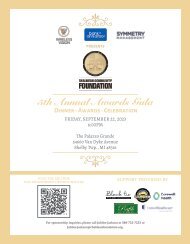Create successful ePaper yourself
Turn your PDF publications into a flip-book with our unique Google optimized e-Paper software.
FEATURE<br />
From above:<br />
Professor Paulo Botta, at the head<br />
of the table, with descendants of<br />
Chaldean immigrants who arrived<br />
in Argentina at the beginning of the<br />
20th Century. Alejandro Safarov is<br />
third from the right.<br />
The French document of Israel Guiberguis,<br />
from Khosrowa, prior to his<br />
arrival to Argentina.<br />
Verdi Isasha with her son, Simón<br />
Safarov, Alejandro’s grandfather.<br />
The Lost Tribe<br />
Connecting with Chaldean<br />
expats in Argentina<br />
BY WEAM NAMOU<br />
In October 2022, Dr. Paulo Botta<br />
visited San Salvador de Jujuy<br />
and El Carmen, two towns of the<br />
Jujuy province in the north of Argentina.<br />
There he met with descendants<br />
of Chaldean Iranians who immigrated<br />
to Argentina between 1900 and<br />
1930.<br />
Botta, a professor of Social Sciences<br />
affiliated with the Pontifical Catholic<br />
University of Argentina, explained,<br />
“Nobody even knows about that group<br />
of Chaldean families who arrived here<br />
almost a century ago.”<br />
In Pursuit of Knowledge<br />
The trip was funded by the Chaldean<br />
Cultural Center (CCC) in West Bloomfield.<br />
Its objective was to talk with the<br />
members of these Iranian immigrant<br />
families who identify as Chaldean and<br />
gather copies of the documents and<br />
photos they’ve kept as part of their<br />
family lore.<br />
This information will be combined<br />
with the archives in Europe so that Dr.<br />
Botta and his university can reconstruct<br />
the situation of those families at<br />
the end of the 19th and the beginning<br />
of the 20th century and their migration<br />
to Argentina.<br />
The two dozen families in<br />
the towns of Jujuy province were<br />
mainly from Patamur and Khosrow,<br />
villages near Lake Urmia in<br />
the northwest part of Iran. “There<br />
is some evidence they also came<br />
from Tchara, Mar Serges, and Heydarlui,<br />
but we need more information<br />
to confirm that,” said Botta.<br />
Botta and others at the university<br />
found documents about this community<br />
in Madrid, Rome, and Paris. The<br />
documents were produced by Catholic<br />
authorities that had encountered the<br />
community during their trip to Argentina.<br />
In 2019, Botta approached the<br />
CCC to discuss funding the exploratory<br />
field research in Jujuy.<br />
As executive director of the CCC,<br />
I was happy to support this project,<br />
along with the board. We are attempting<br />
to capture information about the<br />
Chaldean diaspora and, like Dr. Botta<br />
and the Pontifical Catholic University,<br />
we are interested in creating a digital<br />
archive of the Chaldean Iranians living<br />
in Argentina.<br />
Identifying as Chaldean<br />
These emigrants and their descendants<br />
spoke Syriac at home until the eighties.<br />
They also spoke Persian and Russian,<br />
but their linguistic identity was tied to<br />
the Syriac heritage; it is clear to see on<br />
the gravestones in the section of the<br />
cemetery in El Carmen where they were<br />
buried.<br />
“My family was quite aware of their<br />
origins and called themselves ‘Kaldani,’”<br />
said Alejandro Safarov, professor<br />
at the Catholic University of Santiago<br />
del Estero.<br />
Safarov spoke to the last surviving<br />
member of the first immigrants, Tato<br />
Kamandaro, now deceased. He learned<br />
that in the beginning, the Chaldean<br />
families in Argentina honored their culture,<br />
identity, and traditions, keeping<br />
them alive through family meetings and<br />
celebrations. That all stopped when the<br />
elders wanted to keep the community<br />
as close as possible by choosing whom<br />
the young people would marry.<br />
“Argentina is a very multicultural<br />
society, and it was very hard<br />
to convince the young, who assimilated<br />
very fast, to stay within<br />
their own community,” said Safarov.<br />
“They married with the locals<br />
and other immigrants.”<br />
The Long Journey<br />
Some of the families emigrated<br />
from Iran through the Ottoman<br />
Empire and France towards<br />
South America. Others arrived<br />
through the territories of the<br />
Russian empire in the Caucasus,<br />
what is today the Republic of<br />
Georgia, and they settled temporarily<br />
in Tiblisi and Batumi.<br />
“My paternal great-grandfather<br />
Martin is from Batumi,”<br />
said Safarov. “They left because<br />
of the consequences of the First<br />
World War, the Russian Revolution,<br />
and religious persecution.”<br />
While Safarov says that his<br />
ancestors didn’t like to talk<br />
about the atrocities of that<br />
time, he remembers his grandfather,<br />
Simon, telling him how he, at<br />
age 13, walked over dead bodies to<br />
reach the ship that would take him<br />
and his mother to America.<br />
“America was their destination,”<br />
said Safarov.<br />
The Vatican and Spanish government<br />
representative in Iran, a priest,<br />
organized the trip for many of these<br />
families. This was mostly during the<br />
First World War, some of the families<br />
told Botta.<br />
The family memories agree on the<br />
help they received from the Catholic<br />
orders working in the region, Lazarists<br />
and Daughters of Charity of Saint Vincent<br />
de Paul, who gave them money<br />
and the documents needed for the trip.<br />
24 CHALDEAN NEWS <strong>MARCH</strong> <strong>2023</strong>

















